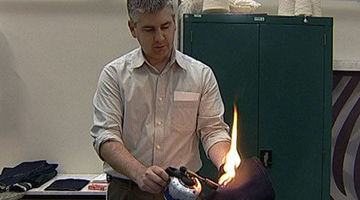New stab and flame-resistant fabric is made on a special type of machine. Dr Stewart Collie, Senior Scientist at AgResearch, explains how the machine creates the unique fabric structure.
The Fibreknit machine creates a knitted structure from a high-performance synthetic yarn and then incorporates wool fibre into this structure from a sliver of fibres. This means the wool fibre doesn’t have to be made into yarn first, cutting out a processing step, which saves production costs and time.
Transcript
Dr Stewart Collie (AgResearch)
The fabric is made on a special type of knitting machine called a Fibreknit machine. It is able to knit a yarn – and we use the Vectran™ in that role – but at the same time, it can take a staple fibre such as wool and knit that from what’s called a sliver, which is really just a loose rope of fibre rather than a yarn. And it is actually a way of short-cutting the manufacturing process in that you can avoid the need to make a wool yarn, which is quite an expensive process. So it’s a knitted fabric.
We take the Vectran™ filament yarn and knit that into a scaffolding structure, and around that fibre, we embed the wool. We tangle it into the knitted loop structure so it’s sort of caught in between the loops of Vectran™ yarn, and then as well as that, some of the finishing processes that we carry out help to fix it in place even better.
So we end up with the wool fibres well held into that structure, anchored to the Vectran™ and also to each other. We end up with a fabric that looks and feels like a conventional wool jacketing or lining type of fabric.



